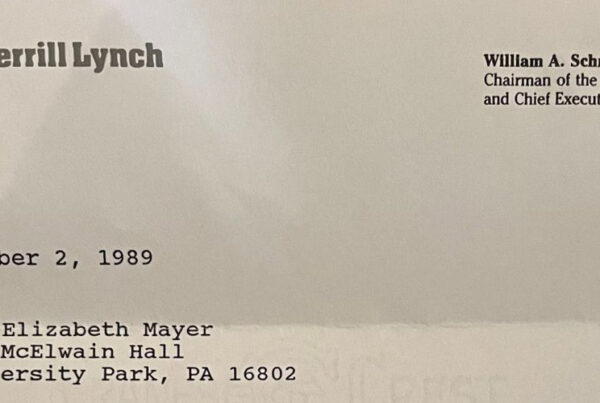
Article Summary: Words are power. Playwright Edward Bulwer-Lytton said it best: “The pen is mightier than the sword.” With so much of today’s business communication going digital — e-mail, text messages, thank you notes, job offers, holiday cards, stories — what you say and how you say it are more critical than ever to great leaders. And nowhere is communication more important than in leadership positions. Many of us have had bosses who had an impact on our careers. During my career, two really stand out.
Great Leaders Know How to Put their Words to Work
Copyright © 2008, Washington Business Journal. Used by permission.
Ira J. Koretsky
December 12, 2008
Words are power. Playwright Edward Bulwer-Lytton said it best: “The pen is mightier than the sword.”
With so much of today’s business communication digital — e-mail, text messages, thank you notes, job offers, holiday cards — what you say and how you say it are more critical than ever to strong and profitable business relationships.
And nowhere is communication more important than in leadership positions.
Many of us have had bosses who had an impact on our careers. During my career, two really stand out. They stand out because of how each treated me. They were great listeners, gently offered advice, supported me, appreciated what I did and showed it. They were leaders, mentors, and coaches.
Why did they make such powerful and indelible impressions? Our shared experiences. Experiences define us, and the stories we share about these experiences help shape the world around us.
We live through each other’s stories. Told right, business stories can have the same impact as personal stories.
Business Stories are Memorable, Powerful Packages that Simplify Messages
Business stories are the engine of relationships, and relationships are the engine of business growth. As a leader, it is crucial to tell the right stories and ensure the right ones are being told about you. Great leaders share their vision, knowledge, and wisdom through stories.
The best stories have several key characteristics: They are simple, are easily understood, have immediate resonance, are delivered passionately, and have a positive outcome or learning experience. Great leaders are great storytellers.
Whether you are speaking at a small, informal meeting or before thousands at a shareholders’ meeting, use stories to be a better leader.
Business stories are the engine of relationships, and relationships are the engine of business growth
It’s All About Them
First, know your audience as well as yourself. Your mantra should be, “It’s all about them.”
The story that plays well with longtime colleagues may not resonate with a potential client. The stories that impressed the group of visiting Asian chief executive officers may fall flat in Chicago. Understanding the audience makes the difference in building the relationship and closing that deal.
What is the Half-Life of Your Story?
During some of my keynote speeches and workshops, I use what I call, a Smart Exercise titled, “What is the Half-Life of Your Story?” It prompts participants to realize the power of words.
Here is an example of the exercise, which can be tailored to suit your group. First, read each of these phrases slowly: recent personal performance review, last big project, most difficult boss and best boss. Then, reread each phrase. What do you immediately think of? A person, a place, event, experience or emotion? Do the experiences these words conjure up make you grimace or smile?
Great leaders reveal personal experiences relevant to their audience, and the goal of this exercise is to tap into your passion. Sharing stories with passion grabs and keep your audience’s attention.
Nowhere is it truer than in business that “we don’t pay attention to boring things,” says John Medina, author of “Brain Rules.”
“We don’t pay attention to boring things,” – John Medina, Author, “Brain Rules”
Once you have identified your stories, think carefully about the words you are using. The words you choose and the stories you tell can elicit positive and negative feelings equally well. Words and stories have context and perspective.
Many words have multiple meanings, and tone and delivery can be understood — or misunderstood — in a number of ways. For example, the expression “You are crazy,” can be playful, argumentative, or even condescending.
People constantly look to leaders for guidance and advice. Remember it is all about them — your audience.
What Stories are You Telling?
As a leader, what stories are you telling? Does your audience find them inspiring and positive? Are you evaluating their strong points and addressing their weak points? Are your stories generating the results you want?
If not, revise and practice the delivery, impact, timing, opening and closing.
Years ago, contracts were made by a smile and a handshake. The simple phrase “you have my word” meant something. Doing business is not so simple today, especially in light of a global economy with diverse cultures, backgrounds and languages.
Whether you own a two-person small business or are CEO of a Fortune 500 company, your words and stories matter to those around you. I believe words and stories have a very long half-life, perhaps hundreds of years depending upon what you say and where you say it (such as books, articles and blogs).
As you build your teams and your business, be deliberate with the stories you tell. Follow the advice of famous novelist Joseph Conrad: “I have no use for engines. Give me the right word … and I will move the world.”
Interested in improving (dramatically) your leadership effectiveness, public speaking, presentation, storytelling, or data storytelling skills?
FURTHER READING – ALL WASHINGTON BUSINESS JOURNAL ARTICLES
- Everyone has a Story to Tell, and You Need One Too (read)
- Say What you Want, Say it in Under 30 Seconds (read)
- Step Away from the Urn, and Other Networking Tips (read)
- Keeping it Real – Learn to Heed Your Authentic Voice (read)
- Getting to Yes – Make Body Language Work for You (read)
- Drop the Dry Presentation, Tell a Compelling Story (Part 1)
- Presenters Must Prepare Like Orchestra Conductors (Part 2)
- Great Leaders Know How to Put their Words to Work (read) (this article)
Photography Source: Photosdisc, vol 69



